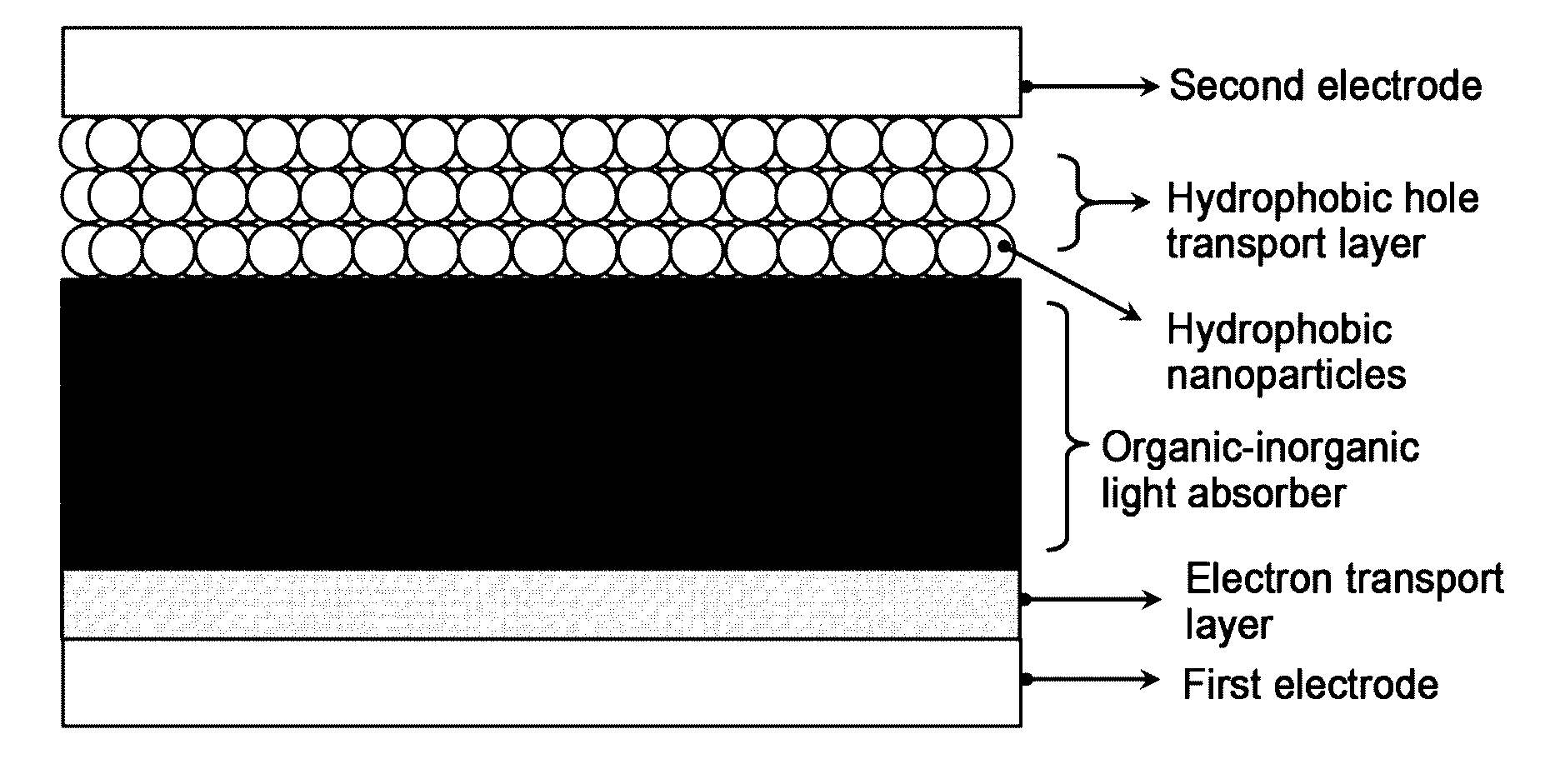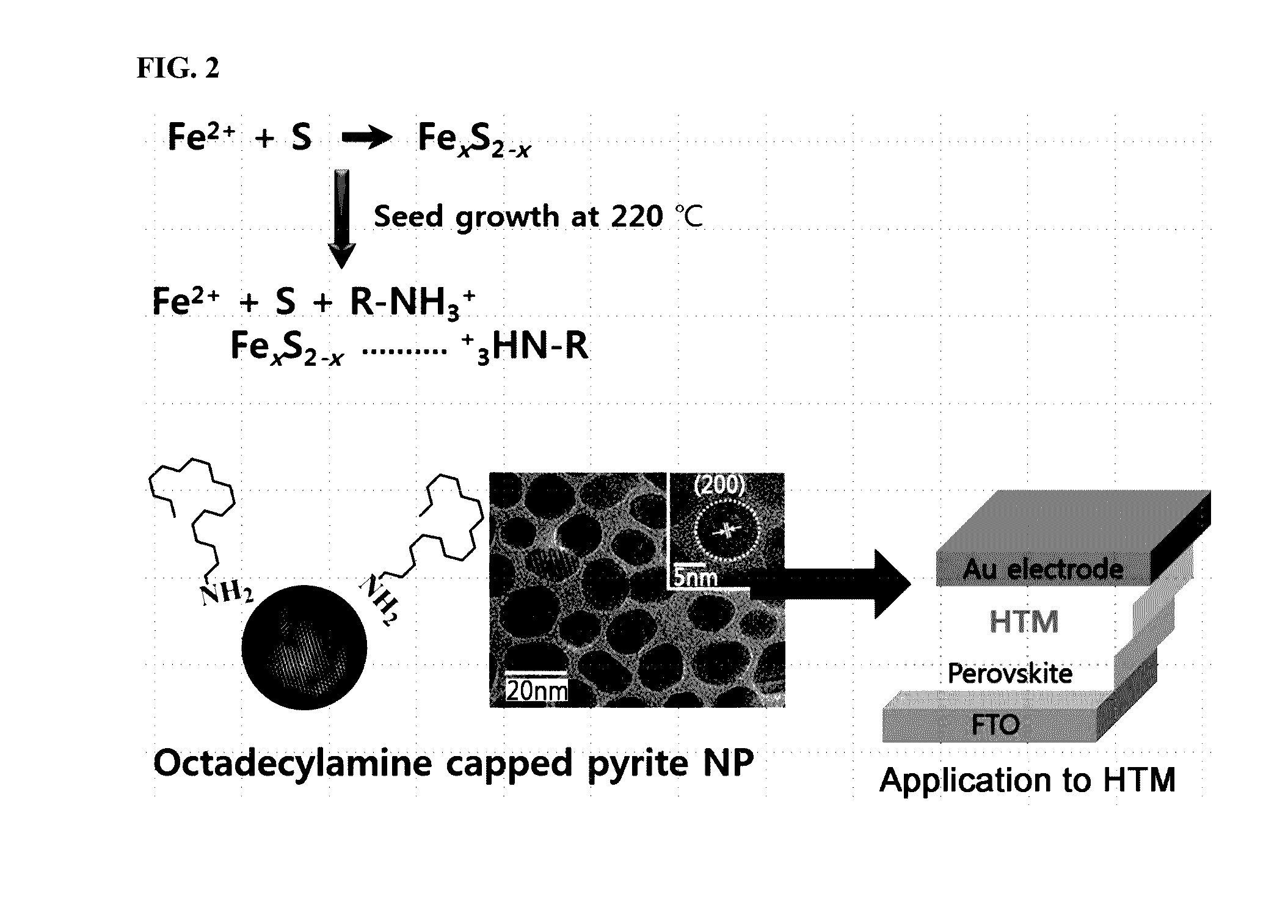Inorganic nanomaterial-based hydrophobic charge carriers, method for preparing the charge carriers and organic-inorganic hybrid perovskite solar cell including the charge carriers
a technology of hydrophobic charge carriers and organic nanomaterials, which is applied in the direction of photovoltaic energy generation, electrical equipment, semiconductor devices, etc., can solve the problems of increasing environmental pollution, affecting the operation stability of perovskite light absorbers, and the price of perovskite susceptible to moisture, etc., to achieve stable operation for a long time, high photoelectric efficiency, and less expensive than organic materials used
- Summary
- Abstract
- Description
- Claims
- Application Information
AI Technical Summary
Benefits of technology
Problems solved by technology
Method used
Image
Examples
example 1
Preparative Example 1
Preparation of Solution for Organic-Inorganic Hybrid Perovskite Absorbing Layer
[0065]Methylammonium iodide (CH3NH3I) and lead diiodide (PbI2) in a molar ratio of 1:1 were dissolved in γ-butyrolactone. The solution was stirred at 60° C. for 12 h to prepare a solution of 40 wt % methylammonium lead triiodide (CH3NH3PbI3).
example 1-1
Preparation of Solution of Hydrophobic Inorganic Nanoparticles
[0066]0.15 mol of FeCl2.4H2O (Aldrich) was dispersed in 0.15 mol of octadecylamine (Aldrich). Residual moisture was removed at 100° C. for 1 h to prepare a first precursor solution. Sulfur was dispersed in diphenyl ether (Aldrich) in such an amount that the sulfur concentration was 15 mg / mL. Residual moisture was removed at 100° C. for 1 h to prepare a second precursor solution. The first precursor solution was sufficiently mixed with the second precursor solution in a 250 mL 3-neck flask. Thereafter, the mixture was thermally decomposed at 220° C. for a controlled time to synthesize nanoparticles. The nanoparticles were purified with a solution of ethyl alcohol and chloroform (9:1, v / v) and dispersed in chloroform.
example 1-2
Fabrication of Organic-Inorganic Hybrid Perovskite Solar Cell
[0067]A glass substrate coated with F-doped SnO2 (FTO) (8 ohms / cm2, Pilkington) was cut to a size of 25×25 mm (hereinafter referred to as an FTO substrate or first electrode). A 0.1 M Ti (IV) bis(ethyl acetoacetato)diisopropoxide (Aldrich) / 1-butanol (Aldrich) solution was spin coated on the first electrode, followed by heat treatment at about 500° C. for about 15 min to form an about 100 nm thick dense anatase TiO2 thin film as an n-type semiconductor layer.
[0068]A solution of 10 wt % of ethyl cellulose and terpinol were added to and mixed with a TiO2 powder (average particle size=20 nm) to prepare a paste solution in which ethyl alcohol and the TiO2 powder were present in a ratio of 8:2. The ethyl cellulose solution and the terpinol were used in amounts of 5 mL and 5 g per gram of the TiO2, respectively.
[0069]The paste solution was spin coated on the TiO2 thin film formed on the FTO substrate, followed by heat treatment a...
PUM
 Login to View More
Login to View More Abstract
Description
Claims
Application Information
 Login to View More
Login to View More - R&D
- Intellectual Property
- Life Sciences
- Materials
- Tech Scout
- Unparalleled Data Quality
- Higher Quality Content
- 60% Fewer Hallucinations
Browse by: Latest US Patents, China's latest patents, Technical Efficacy Thesaurus, Application Domain, Technology Topic, Popular Technical Reports.
© 2025 PatSnap. All rights reserved.Legal|Privacy policy|Modern Slavery Act Transparency Statement|Sitemap|About US| Contact US: help@patsnap.com



